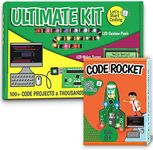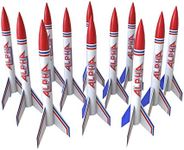Buying Guide for the Best Rocket Kits
Choosing the right rocket kit can be an exciting and rewarding experience, whether you're a beginner or an experienced hobbyist. The key to finding the best rocket kit for you is to understand the different specifications and how they align with your interests and skill level. Here are some important factors to consider when selecting a rocket kit.Skill LevelRocket kits are typically categorized by skill level, ranging from beginner to expert. This specification is important because it indicates the complexity of the assembly and the level of experience required. Beginners should look for kits labeled as 'Level 1' or 'Beginner,' which are easier to assemble and require fewer tools. Intermediate users might choose 'Level 2' or 'Level 3' kits, which offer more of a challenge and may include more intricate parts. Advanced hobbyists can opt for 'Level 4' or 'Level 5' kits, which often require advanced building techniques and a deeper understanding of rocketry. Choose a skill level that matches your experience to ensure a successful and enjoyable build.
Rocket SizeThe size of the rocket is another important specification to consider. Rocket size can affect both the building process and the launch experience. Smaller rockets are generally easier to handle and assemble, making them ideal for beginners and younger hobbyists. Medium-sized rockets offer a balance between ease of assembly and impressive launches, suitable for intermediate users. Larger rockets can be more challenging to build and require more space for launching, but they provide a more dramatic and rewarding launch experience. Consider where you will be launching your rocket and how much space you have available when choosing the size.
Engine TypeRocket engines come in various types and sizes, and this specification is crucial for determining the rocket's performance. Engines are typically classified by letters (e.g., A, B, C, D), with each letter representing a different level of thrust. Lower letter engines (A, B) provide less thrust and are suitable for smaller rockets and beginners. Higher letter engines (C, D) offer more thrust and are better suited for larger rockets and more experienced users. Some kits come with engines included, while others require you to purchase them separately. Make sure to choose an engine type that matches your rocket kit and your comfort level with handling more powerful launches.
Recovery SystemThe recovery system is a critical component that ensures your rocket returns safely to the ground after launch. Common recovery systems include parachutes, streamers, and gliders. Parachutes are the most popular and provide a gentle descent, making them ideal for most users. Streamers are simpler and can be used for smaller rockets, offering a quicker descent. Gliders are more advanced and allow the rocket to glide back to the ground, which can be more challenging to achieve. Consider the type of recovery system that best suits your skill level and the environment where you will be launching your rocket.
MaterialsRocket kits can be made from various materials, including plastic, wood, and cardboard. The material affects the durability, weight, and ease of assembly. Plastic kits are durable and often easier to assemble, making them great for beginners. Wooden kits offer a more traditional building experience and can be more durable, but they may require more tools and skills. Cardboard kits are lightweight and easy to assemble, but they may not be as durable as plastic or wood. Choose a material that matches your building skills and the level of durability you need for your rocket.




















